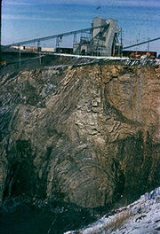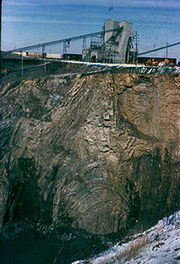
Kentland crater
Encyclopedia

Impact crater
In the broadest sense, the term impact crater can be applied to any depression, natural or manmade, resulting from the high velocity impact of a projectile with a larger body...
located near the town of Kentland
Kentland, Indiana
Kentland is a town in Jefferson Township, Newton County, Indiana, United States. The population was 1,748 at the 2010 census. The town was founded in 1860 as "Kent", though this name was soon lengthened to Kentland. The name honors Alexander Kent, who acquired the then marshy plat and prepared it...
in Newton County, Indiana
Newton County, Indiana
Newton County is a county located in the U.S. state of Indiana. As of 2010, the population was 14,244. The county seat is Kentland.- History :...
, United States.
It was discovered about 1880 when two farmers began to quarry
Quarry
A quarry is a type of open-pit mine from which rock or minerals are extracted. Quarries are generally used for extracting building materials, such as dimension stone, construction aggregate, riprap, sand, and gravel. They are often collocated with concrete and asphalt plants due to the requirement...
crushed rock there. The presence of shatter cone
Shatter cone
Shatter cones are rare geological features that are only known to form in the bedrock beneath meteorite impact craters or underground nuclear explosions...
s and deformed bedrock
Bedrock
In stratigraphy, bedrock is the native consolidated rock underlying the surface of a terrestrial planet, usually the Earth. Above the bedrock is usually an area of broken and weathered unconsolidated rock in the basal subsoil...
led geologists to conclude by the late 1960s that the Kentland structure is an impact crater
Impact crater
In the broadest sense, the term impact crater can be applied to any depression, natural or manmade, resulting from the high velocity impact of a projectile with a larger body...
, rather than volcanic
Volcano
2. Bedrock3. Conduit 4. Base5. Sill6. Dike7. Layers of ash emitted by the volcano8. Flank| 9. Layers of lava emitted by the volcano10. Throat11. Parasitic cone12. Lava flow13. Vent14. Crater15...
in origin. Deformation at the site is so great that vertical contacts between normally horizontal rock formations of different ages are common.
The crater itself is a circular dome
Dome
A dome is a structural element of architecture that resembles the hollow upper half of a sphere. Dome structures made of various materials have a long architectural lineage extending into prehistory....
, about 7.24 km (4.5 mi) in diameter, deeply eroded and buried in glacial
Glacier
A glacier is a large persistent body of ice that forms where the accumulation of snow exceeds its ablation over many years, often centuries. At least 0.1 km² in area and 50 m thick, but often much larger, a glacier slowly deforms and flows due to stresses induced by its weight...
debris. Its age is estimated to be less than 97 million years (Cretaceous
Cretaceous
The Cretaceous , derived from the Latin "creta" , usually abbreviated K for its German translation Kreide , is a geologic period and system from circa to million years ago. In the geologic timescale, the Cretaceous follows the Jurassic period and is followed by the Paleogene period of the...
or younger). The Shakopee dolomite at the center of the structure is about 450 million years old (Ordovician
Ordovician
The Ordovician is a geologic period and system, the second of six of the Paleozoic Era, and covers the time between 488.3±1.7 to 443.7±1.5 million years ago . It follows the Cambrian Period and is followed by the Silurian Period...
period) and is uplifted about 2,000 feet higher than the level of the same rock in the surrounding area. The entire disturbed area is about 13 km (8.1 mi) in diameter.
The crater's structure was studied in 1978. John Weber and his associates presented fission track dating
Fission track dating
Fission track dating is a radiometric dating technique based on analyses of the damage trails, or tracks, left by fission fragments in certain uranium-bearing minerals and glasses...
of apatite
Apatite
Apatite is a group of phosphate minerals, usually referring to hydroxylapatite, fluorapatite, chlorapatite and bromapatite, named for high concentrations of OH−, F−, Cl− or Br− ions, respectively, in the crystal...
from the crater at the Society for Sedimentary Geology
Society for Sedimentary Geology
The Society for Sedimentary Geology is an international not-for-profit, scientific society based in Tulsa, Oklahoma. It is commonly referred to by its acronym SEPM, which refers to its former name, the Society of Economic Paleontologists and Mineralogists.The Society’s reason for being is to...
(SEPM) Research Conference, "The Sedimentary Record of Meteor Impacts" (21–23 May 2003, Springfield, Missouri
Springfield, Missouri
Springfield is the third largest city in the U.S. state of Missouri and the county seat of Greene County. According to the 2010 census data, the population was 159,498, an increase of 5.2% since the 2000 census. The Springfield Metropolitan Area, population 436,712, includes the counties of...
). Coesite
Coesite
Coesite[p] is a form of silicon dioxide SiO2 that is formed when very high pressure , and moderately high temperature , are applied to quartz. Coesite was first synthesized by Loring Coes, Jr., a chemist at the Norton Company, in 1953. In 1960, coesite was found by Edward C. T...
and shatter cone
Shatter cone
Shatter cones are rare geological features that are only known to form in the bedrock beneath meteorite impact craters or underground nuclear explosions...
s are found in the uplift near its center. The crater is exposed to the surface, resulting in erosion. It is currently being worked as a quarry.
External links
- Bibliography for Kentland Crater
- Abstract: Geochemical Study of Rocks from the Kentland, Indiana, Impact Structure
- Abstract: Structural Study of the Kentland, Indiana, Impact Site
- Abstract: John C. Weber et al., "The Kentland Impact Crater, Indiana (USA): An Apatite Fission-Track Age Determination Attempt", in Christian Koeberl and Herbert Henkel (eds.) Impact Tectonics, Berlin and Heidelberg: Springer, 2005, pp. 447-466. ISBN 978-3-540-24181-2
- Kentland Quarry photos

